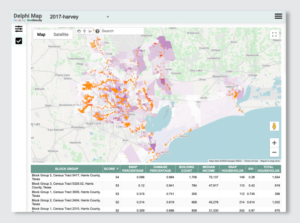
As COVID accelerates innovative uses of AI in many areas, we are also seeing more development of AI-powered data mapping tools for philanthropic advising and to support donor investment decisions. In our report, Unlocking Generosity with Artificial Intelligence: The Future of Giving (ai4giving), Allison Fine and I identified examples of where the algorithms and data are used to provide recommendations for philanthropic investment – whether everyday donors, program officers, or major donors. The technology helps donors make investments that yield the highest impact or strategic system change. We are seeing it to help donors make decision about COVID funding and other disaster related donation decisions.
In general terms, Philanthropic advising usually consists of identifying:
- A donor’s objectives based on their interests,
- The most pressing needs within social impact areas or geographic locations,
- Nonprofits working to address those needs,
- Which of these nonprofits is most effective,
- Additional variables such as giving models, tax implications, legal considerations etc.
Before the pandemic, Rhodri Davies, head of policy at Charities Aid Foundation (CAF), authored the 2019 white paper, “Machine Made Goods: Charities, Philanthropy, and Artificial Intelligence,” describing the opportunities. “If we use machine learning to analyze data both on need and on the social impact of nonprofits and other interventions, it would enable identification of where the most pressing needs were at any given time, as well as the most effective ways of addressing those needs through philanthropy, and thus potentially enable a rational matching of supply and demand.”
Davies coined the term “philgorithm” to describe the use of algorithms to detect basic patterns or gaps in a donor’s strategy. He is clear that artificial intelligence would not eliminate the jobs of program officer or philanthropic advisor but augment them. Davies predicts that once these systems are fully enabled, they will change the way people invest in social change.
Pre-pandemic, philanthropic advising was squarely in the embryonic stage, but the pandemic has accelerated the development of these systems.
Here are some recent examples:
The Nonprofit Aid Visualizer—NAVi—powered by Vanguard Charitable integrates several large data sets on an interactive platform, making it easy to find charities solving the problems that donors care about and want to support.
The COVID-19 pandemic has shined a light on gaps in information that donors need as they try to support relief efforts. NAVi seeks to fill these gaps. The interactive mapping tool harnesses COVID-19 incidence rates, community vulnerability scores, and detailed nonprofit profiles to help donors invest in the communities most affected by the pandemic. You can read more about the methodology here. Machine learning is most likely being used to help with the data coding and categorization in the underlying databases.

Source: GiveDirectly Facebook Page
According to this Fast Company article, another example, is a partnership between GiveDirectly and Google.org aims to smooth the process of disaster relief funds to the people who need them most urgently due natural disasters caused by climate change (recent wildfires, hurricanes, and tornados.)
GiveDirectly helps disaster victims via direct cash transfers is working in partnership with Google to launch Delphi, an online tool that allows aid organizations to pinpoint the specific locations, down to granular zip-code level, most in need of assistance. The data-driven effort creates scores based on the overlap between two metrics—poverty level and destruction of property—then ranks and shows those neighborhoods visually in Google Maps. The indexes are created by an algorithm.
The tools allows them to take a data-driven approach that provides a more comprehensive picture of who needs the aid the most. In the past, they relied on media coverage, phone calls, on-the-ground searches, and information collected by other organizations. This approach often leaving less visible communities disregarded.
A team of four Google Fellows developed Delphi (named after the ancient Greek shrine that was home to an oracle who could predict the future) over the span of six months. They used Earth Engine and plugged various data sets including census block data for locations, SNAP (food stamp) data for poverty levels, and data from the National Oceanic and Atmospheric Administration for property damage. GiveDirectly would then target those communities with direct cash relief.
The future plan is to use this tool with other aid organizations and types of natural disasters such as wildfires. The “AI Dividend” is that nonprofit organizations will save time, and field costs because fieldwork will become more efficient.
As Allison Fine and I like to say, we are just at the beginning of the adoption curve for these emerging technologies. While the benefits and potential is great, there are also challenges as we outlined in our report.

Leave a Reply